Thursday, 3 August, Moscow: Red Square, cathedrals, the metro, more touring, and cruising to Uglich
Written 29 August 2017
Thursday was our last day in Moscow. The new items on the breakfast buffet were Slices of herring (presumably pickled in some way, but not as sour as the ones I'm used to), a bowl of ripe plums, and more smoked cheese, this time in the form of little round buttons. A waiter passed a basket of pastries from table to table, the same ones every day: a large poppy-seed filled crescent-shaped one and an equally large half-moon turnover filled with strawberry jam. I tried both in the course of the cruise. Both were good, but I wish they'd come in smaller sizes.
Then it was off to the buses one more time. And one more time our tour escort regaled us with reams of information about Russia and particularly about Moscow.
- Normal working hours are 9-6 Monday through Friday, and too everyone agrees that far too many people commute individually by car.
- Moscow has five airports. One in the east, the others in the wast and southwest. Two are strictly domestic, the others both domestic and international.
- YUri the Long-Armed is regarded as the father of the city.
- The city takes its name from the Moscow River, which runs through it. In September they'll celebrate 870 years since the city's founding.
- Moscow's in a very convenient location because it's at a crossroads of both water and land transportation routes.
- Matryushka (like the nesting dolls) means "mother." "Matryushka Volga" means "Mother Volga."
- A canal (where our ship is moored) connects the Moscow River and the Volga.
- Mikael Gorbachov is still alive, in his 80's but still active.
- A project is underway to renovate all the apartment house facades and underground all the wires that mar the view in Moscow.
- The building with statues of horses on top is the 1834 Hippodrome.
- The price of a 3-room apartment (i.e., 1 living room and 2 bedrooms) in Moscow is about 120-180 million rubles (divide by 60 for dollars).
- The price per square meter of an apartment in Moscow is about 2-3 thousand dollars.
- We drove on part of the 36-km ring road; some parts of town have trams; others have only trolley buses and the metro. They're trying to get rid of all the trolley tracks and convert entirely to trolley buses.
- At the beinning of 2017, Moscow's population was over 12 million.
- The Metro carries 7-9 million people a day.
- Up to 21 million people are in the city at any given time (including those that commuite in).
- 5 million private cars registered in the city.
- Moscow no longer has any communal apartments, but some remain in St. Petersburg. We were given the opportunity to visit one and talk to the residents, but we didn't sign up for that.
- Our guide claims that Moscow is female and St. Petersburg male. I would have said just the opposite.
- The guide pointed out Moscow Studios, where Russian Films are made. War and Peace and Moscow Does Not Believe in Tears, both made there, were both nominated for Oscars.
Written 30 August 2017
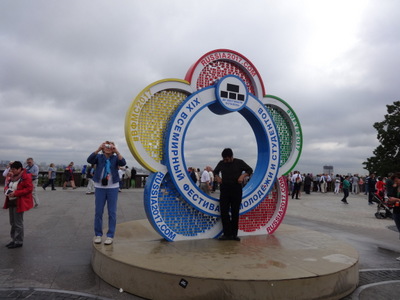
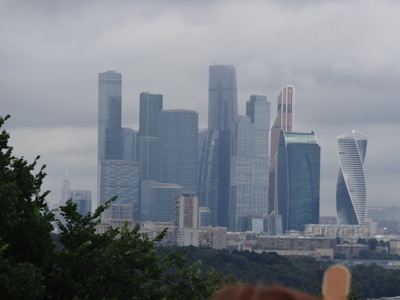 Our first stop was Sparrows Hills again, to see it in daylight. It's at 80 m altitude, and we could see about 1/4 of the city from it. The strange multicolored object (with tourist posing in front of it) is advertising the the Festival of Youth, which Will take place in September in Sochi.
Our first stop was Sparrows Hills again, to see it in daylight. It's at 80 m altitude, and we could see about 1/4 of the city from it. The strange multicolored object (with tourist posing in front of it) is advertising the the Festival of Youth, which Will take place in September in Sochi.
Moscow struck me as surprisingly devoid of wildlife. Up here, I saw some pigeons and a couple of willy wagtails, but that was about it.
The cluster of skyscrapers at the right is the dvelopment called "Moscow City" (or sometimes "Moscow Manhattan," it's also reminiscent of La Defense in Paris). Its tallest building, the Federation Tower, actually consists of two towers and is at 374 m is the tallest tower in Europe. (The 20-room penthouse on its 25th floor goes for 30 million dollars). The lower round building in the middle is the Novotel. The project went bankrupt during construction, so the city bought it. Part of it is for financial-institution offices, the rest for residential appartments.

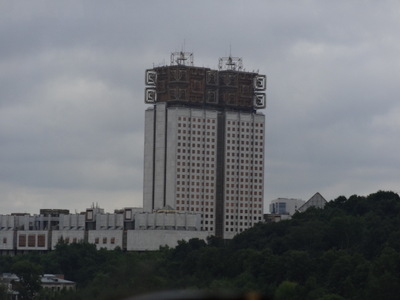 The low, flat dome in the left-hand photo is a huge sports stadium. Behind it and to the left is the building of the Russian Academy of Sciences.
The low, flat dome in the left-hand photo is a huge sports stadium. Behind it and to the left is the building of the Russian Academy of Sciences.
At the right is a photo of the academy by itself. The complicated mesh structure on top is apparently an array of solar panels, but its convoluted shape gives it a certain brain-like air. We had a cloudy day, but we were told that when the sun shines, the whole thing glows gold and is referred to as the "Golden Brain of Russia."
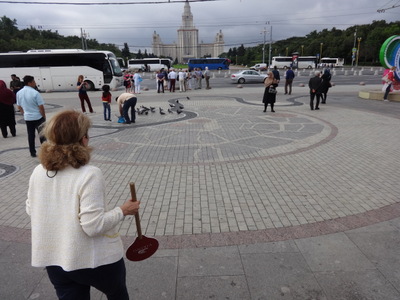
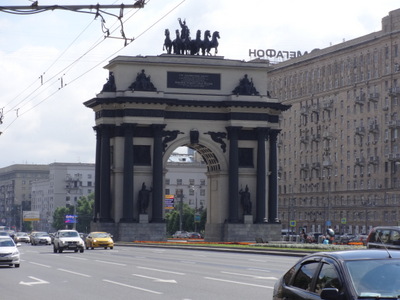 A feature we hadn't notice in the dark the night before is this large map of Moscow laid out in the pavement (at your feet when you turn your back on the view over the balustrade). You can see the Moscow river winding through the city as well as the two ring roads. The Kremlin is marked by a star in the center of the central reddish circle, and Red Square is visible as the larger area of light-colored "roadway" next to it.
A feature we hadn't notice in the dark the night before is this large map of Moscow laid out in the pavement (at your feet when you turn your back on the view over the balustrade). You can see the Moscow river winding through the city as well as the two ring roads. The Kremlin is marked by a star in the center of the central reddish circle, and Red Square is visible as the larger area of light-colored "roadway" next to it.
The tall building in the background of this photo is the Stalin high-rise that houses the seat of Moscow University.
The Stalin high-rises were all built between 1947 and 1957. They now house a couple of apartment buildings, the Russian white house, Moscow University, a couple of hotels, and the Ministry of Foreign Affairs.
Then back to the buses for the short trip to our next destination, Victory Park. The right-hand photo shows the triumphal arch there, built by Alexander I to commemorate the victory over Napoleon.
On the way, we learned that
- The population of the Russian federation is 145 million people, 44 million of whom are pensioners.
- Life expenctancy is 71–75 for women, 70–74 for men.
- During Soviet period, the choice of consumer goods was much narrower—you might see only one or two types of sausage or cheese—but the quality was higher.
- It was Stalin who called the church the opium of the masses.
- The Moscow river is over 600 km long, 82 km within the city, 50 bridges.
- A famous novel, House on the Embankment tells the story of people purged during Soviet times from a house that was pointed out to us on the river bank.
- The Kremlin is closed to the public on Thursdays.
I also added an Audi dealership to the list of those I've spotted in the city.
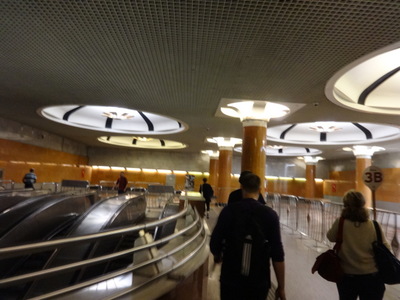
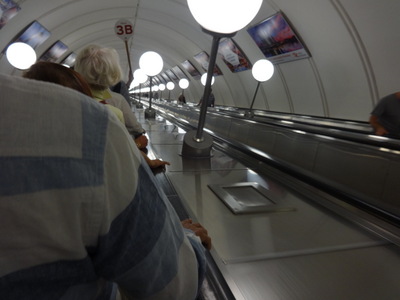 We came to Victory Park (Park Pobedy), via the third ring road, primarily because it's a good place for the buses to let us off so that we can take metro line 2 (the blue one) two stops (to Smolenska) to visit Arbat St., a pedestrian shopping street. The northern terminal of line 2 is the dock where our ship is moored.
We came to Victory Park (Park Pobedy), via the third ring road, primarily because it's a good place for the buses to let us off so that we can take metro line 2 (the blue one) two stops (to Smolenska) to visit Arbat St., a pedestrian shopping street. The northern terminal of line 2 is the dock where our ship is moored.
A circle railway line at the level of the outer ring road is now part of the Metro. The Metro proper has a circle line and 13 radial lines. It has 200 stations and is still expanding. It opened in 1935 with the first 10 stations on line 1 (the red one). All the lines are numbered in the order they were put into service.
Victory Park now also includes memorials for World Wars I and II as well. In Russia they're called the Patriotic Wars (WWII is the Great Patriotic War).
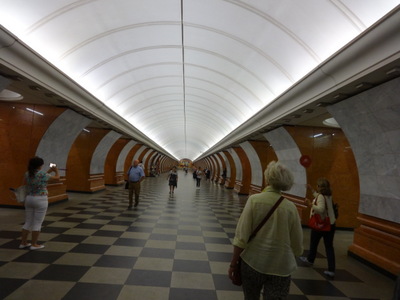
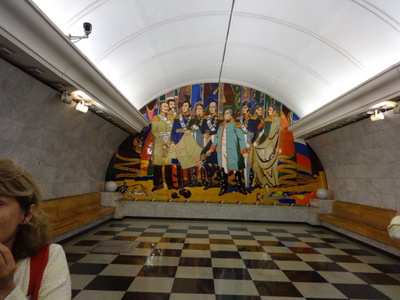 As you can see from these photos and the two above the metro stations are beautiful!
A single ticket is 45 rubles (about 75 cents), and it's it will take you anywhere in the city. The guide used a multiride tap card to put us through the turnstiles one at a time. Actually they are automatic flap gates rather than turnstiles; much more comfortable.
As you can see from these photos and the two above the metro stations are beautiful!
A single ticket is 45 rubles (about 75 cents), and it's it will take you anywhere in the city. The guide used a multiride tap card to put us through the turnstiles one at a time. Actually they are automatic flap gates rather than turnstiles; much more comfortable.
The Victory Park station is quite new (2003-04) and uses many colors of marble. To get there, we went down the longest escalator in the system. The line is 80 m below ground, and the escalator is about 100 m long. The guide warned us that it moves faster than American ones do, so we watched our step carefully. The floors were black and white granite, the walls red and white marble.
The most beautiful stations are supposed to be those on the circle line; they're all dedicated to the victory over Napoleon. The lovely mural on the end wall is actually a mosaic of glazed ceramic tiles.
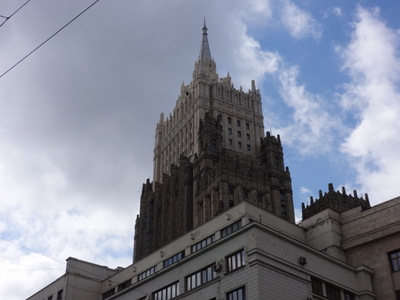
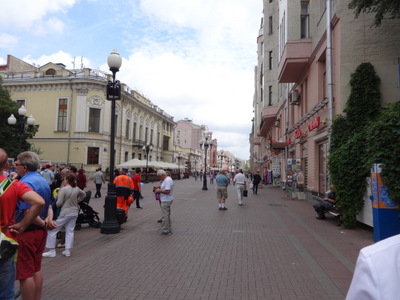 At the far end of our Metro ride, we emerged to this view of the Ministry of Foreign Affairs (one of Stalin's highrises), which is in the process of being cleaned. You can really see the difference between the clean upper floors and the rest, still waiting for attention.
At the far end of our Metro ride, we emerged to this view of the Ministry of Foreign Affairs (one of Stalin's highrises), which is in the process of being cleaned. You can really see the difference between the clean upper floors and the rest, still waiting for attention.
The right-hand photo is a veiw down Arbat Street from its head. We didn't have time to walk its whole length, but we strolled down a ways and back, looking in the shop windows and reading the many commemorative plaques.
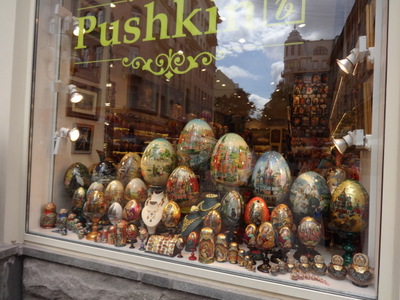
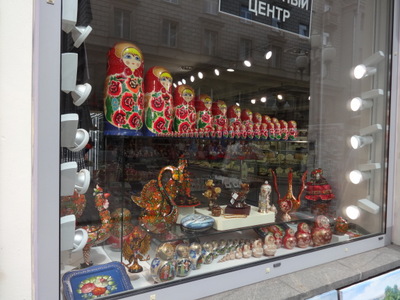 The shop windows featured all the usual Russian souvenirs, but at a very high level. Whole shops were dedicated to amber carvings and jewelry. At the left here is a window full of painted Easter eggs of all sizes.
The shop windows featured all the usual Russian souvenirs, but at a very high level. Whole shops were dedicated to amber carvings and jewelry. At the left here is a window full of painted Easter eggs of all sizes.
The window at the right featured this amazing matryushka doll of (count 'em) 39 pieces! The most we saw anywhere else on our travels was 18 pieces, and those cost a fortune! Arrayed below it were reproductions of Fabergé eggs, smaller matryushkas, lacquered boxes (another frequent offering), and amber items. No prices were visible, of course.
A commemorative placque on a greenish building in Arbat Street marks the house that Pushkin rented for a while, and a statue of poet and singer Borad Okuchoba strolls under a bent arch. He was the bard of Arbat street. He lived here and wrote poems and songs about the street.
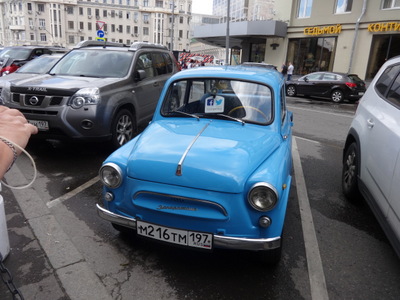
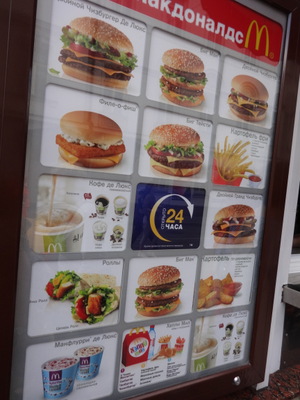 Our guide was delighted to spot this little blue Soviet-made car parked on the street. It's hard to make out the logo on the front, but I think it's a Lada.
Our guide was delighted to spot this little blue Soviet-made car parked on the street. It's hard to make out the logo on the front, but I think it's a Lada.
And I just had to include this MacDonald's menu. Armed with my rudimentary transliteration skills, I was actually able to read most of it, thanks to Russias propensity for borrowing words from other languages. Unfortunately, it doesn't give prices.
At the very top, you can read most of the word "MacDonald's." The label on the center top item transliterates "big mac," the one below it "big tasty." The fish sandwich, left side of second row, is labeled "filet-o-fish," and the fries are labeled "kartofel fry" (kartofel is the German word for potato). I couldn't read most of the words in the little list that accompanies the fries, but a couple of them look like "barbecue" and "curry," so they may be dipping sauces. "Coffee," "latte," and "Happy Meal" also transliterate directly, as does "fish roll" (next to the wraps), and "[something I can't read, probably meaning "chicken"] roll." The term "deluxe" appears frequently, and the stuff in cups at the lower left is labeled "Macflurry deluxe" (which, Google tells me, is pretty much what they're called in English, except that McDonald's just uses the "Mc," whereas in Russian they stick in the "a" in "Mac," because apparently "Mk" wouldn't work in Russian. Wish I'd gotten the price list.
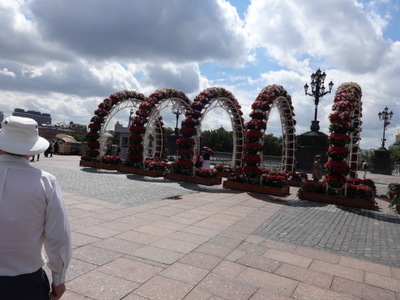
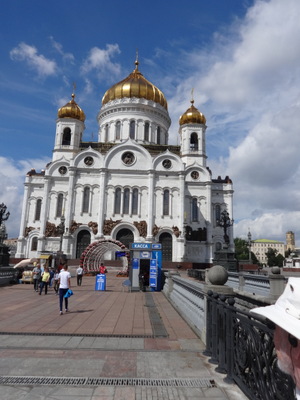 Next, the bus took us to tour St. Saviours cathedral, one of the largest in Russia. To get there, we had to walk over a bridge over the Moscow River. The entrance to the bridge was marked by these flowered arches (it's apparently a popular wedding venue). They're pretty, but again all the flower ar fake.
Next, the bus took us to tour St. Saviours cathedral, one of the largest in Russia. To get there, we had to walk over a bridge over the Moscow River. The entrance to the bridge was marked by these flowered arches (it's apparently a popular wedding venue). They're pretty, but again all the flower ar fake.
The cathedral is a replica because it was destroyed in the 1940s. The original one was only 40 years old, celebrating the victory over Napoleon. It took 40 years to build, it stood for 40 years, and it was destroyed in 40 min, although it took the explosives experts three tries to bring it down. (All the icons and gold were removed beforehand and saved, and the white marble was used to decorate the subway stations). Stalin wanted the site, because he planned to build a 450-m Palace of the Soviet there, but it never happened. They had dug the footings, but then the war stopped the work. Later, Khruschev suggested making the hole into a swimming pool, but that never happened either. The new cathedral will hold 10,000 standing people. It was built from 1995 to 2000.
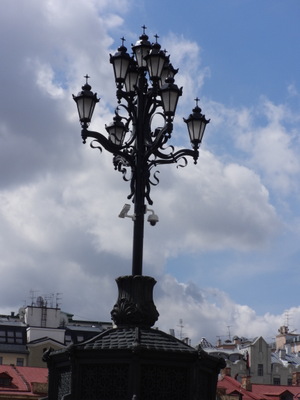
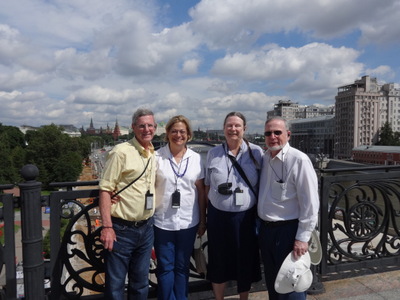 The bridge is embellished with these elaborate wrought-iron lampposts, and while we were there, it was also embellished by our four smiling faces. A fellow Viking cruiser took our photo. You can see the distant towers of the Kremlin just to the left of Ev's head.
The bridge is embellished with these elaborate wrought-iron lampposts, and while we were there, it was also embellished by our four smiling faces. A fellow Viking cruiser took our photo. You can see the distant towers of the Kremlin just to the left of Ev's head.
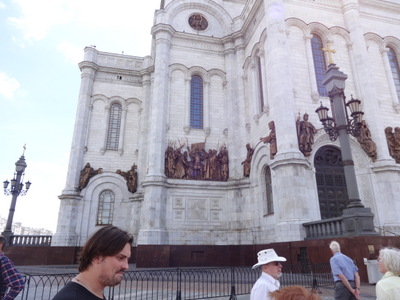
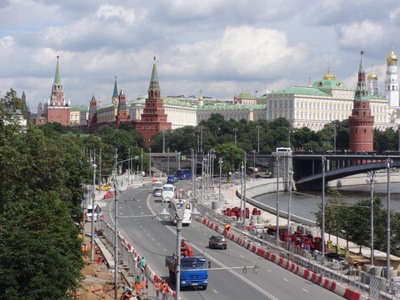 The cathedral is an active chuch, so no photos were allowed inside, but here you can see the frieze of figures around the outside. On the original building were they were white marble, but the new ones are made of copper.
The cathedral is an active chuch, so no photos were allowed inside, but here you can see the frieze of figures around the outside. On the original building were they were white marble, but the new ones are made of copper.
The bridge also afforded a nice view of the Kremlin, so I cranked up the zoom on my little camera. The tallest white tower with the gold dome at the far right edge is the Delphian bell tower, marking the location of the Tsar bell; the red towers are part of the Kremlin wall.
On the highway below the bridge, you can see many red and white Jersey barriers. When the bus dropped us off, we were down there and had to thread our way among the construction before climbing the stairs up to the bridge.
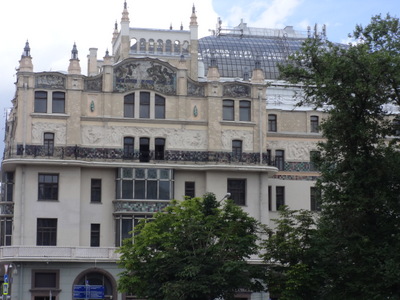
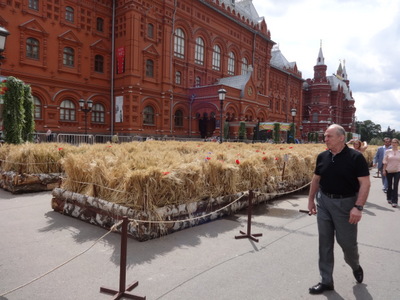 On the way to our final stop of the day, a brief visit to GUM, I finally got a better shot (left-hand photo) of the Hotel Metropol. It's name, in big letters on the side of the building, is hidden by the trees at the right-hand side.
As we walked (from a new direction) toward the entrance to Red Square, we passed a small open-air souvenire market, some temporary flower beds constructed of annuals in planters, and these little plots of grain (wheat, I think). Every now and then Paris does the same thing—sets up flower beds on the steps of the Madeleine and grows wheat down the median of the Champs Elysées.
On the way to our final stop of the day, a brief visit to GUM, I finally got a better shot (left-hand photo) of the Hotel Metropol. It's name, in big letters on the side of the building, is hidden by the trees at the right-hand side.
As we walked (from a new direction) toward the entrance to Red Square, we passed a small open-air souvenire market, some temporary flower beds constructed of annuals in planters, and these little plots of grain (wheat, I think). Every now and then Paris does the same thing—sets up flower beds on the steps of the Madeleine and grows wheat down the median of the Champs Elysées.
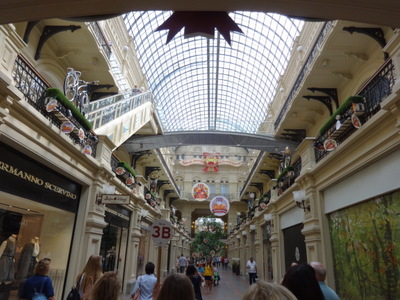
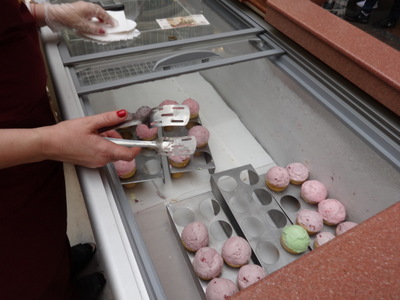 Unfortunately, our time inside GUM was very short, not enough to do any actual shopping or, as I wanted to do, climb up to the food court on the top floor to photograph menus. Rachel did have time to buy an ice cream cone, though. She prides herself on having eaten ice cream in every country she's ever visited.
Unfortunately, our time inside GUM was very short, not enough to do any actual shopping or, as I wanted to do, climb up to the food court on the top floor to photograph menus. Rachel did have time to buy an ice cream cone, though. She prides herself on having eaten ice cream in every country she's ever visited.
GUM is apparently famous for its ice cream cones, and the ground floor was full of ornate little pushcarts selling them, each with a long queue waiting to be served. They could never keep up if they scooped each cone on demand, so instead, their freezers are full of ready-made cones in three or four flavors, which the clerks simply fish out of racks with special tongs and hand to customers. Guys come around with big freezer cases on hand trucks, delivering fresh racks of cones as the old ones are depleted. I don't know whether all ice cream cones in Russia are dispensed in that way or whether GUM is a special case.
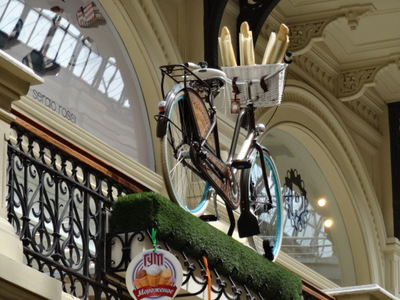
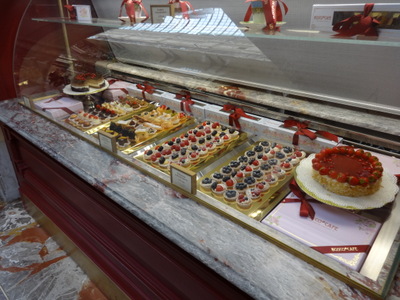 The railings on the second floor, surrounding the central atria, are all decorated with these bicycles, each with a few (presumably artificial) baguettes in its basket.
The railings on the second floor, surrounding the central atria, are all decorated with these bicycles, each with a few (presumably artificial) baguettes in its basket.
I spotted this gorgeous bakery window in one of the shops—lots of tiny fruit tarts, a few chocolate ones at the far end, and a lovely cake in the foreground decorated on the sides with sliced almonds and on top with whole strawberries and red currants.
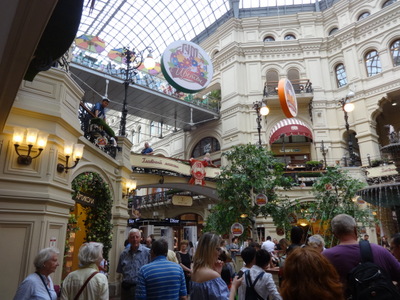
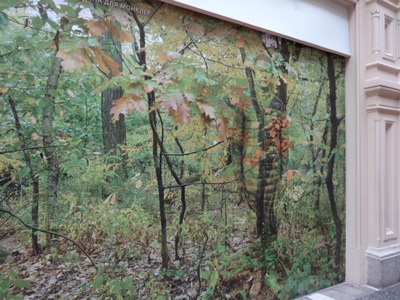 The place really is huge. The vast facade that faces Red Square is only the front of the first range; three more ranges run parallel behind it, all interconnected by crosswise galleries, and each one is three or four stories tall. The hallways and intersections are numbered, to help you keep track of where you are.
The place really is huge. The vast facade that faces Red Square is only the front of the first range; three more ranges run parallel behind it, all interconnected by crosswise galleries, and each one is three or four stories tall. The hallways and intersections are numbered, to help you keep track of where you are.
The shops we walked past were all extremely upscale and expensive. The guide told us that the higher up you went the less expensive the shops were, so near the top you might find places where you'd actually buy something. I wish we'd had time to explore a little more.
I did encounter this fascinating mural there (you can see part of it in a photo above). AT first glance, it's just a photo of a leafy forest, but if you look closely, you can see the figure of a man (Mao Tse-tung, I think) lurking in it. Two tree trunks are larger than the others. Start with the lower trunk of the left-hand one, where you'll see an odd sort of alligator-skin effect. That's the quilting of a long jacket. Follow it upward until the trunk forks. In the fork, you can make out the face. Very strange.
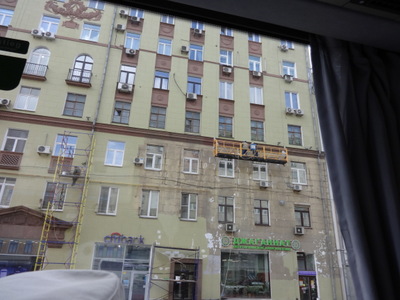
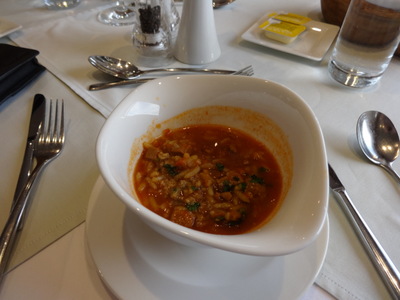 We briefly lost track of one member of our group (her husband bypassed their agreed rendezvous point and rejoined the group without her while she waited for him), but the assistant guide had stayed with her and sorted it out by phone with the head guide. As a result, we were running a little late and had a deadline to meet, so it was back into the buses and off to the ship. On the way, I finally got a good shot of the renovations taking place. In the left-hand photo, you can see buys sitting or standing on planks suspended from the roof of a building, painting its facade. Above them, the paint is bright an attractive. Below them, it's all gray, discolored and scarred (probably worse that it looked before they arrived, because they surely scraped the whole thing down before beginning the repainting job.
We briefly lost track of one member of our group (her husband bypassed their agreed rendezvous point and rejoined the group without her while she waited for him), but the assistant guide had stayed with her and sorted it out by phone with the head guide. As a result, we were running a little late and had a deadline to meet, so it was back into the buses and off to the ship. On the way, I finally got a good shot of the renovations taking place. In the left-hand photo, you can see buys sitting or standing on planks suspended from the roof of a building, painting its facade. Above them, the paint is bright an attractive. Below them, it's all gray, discolored and scarred (probably worse that it looked before they arrived, because they surely scraped the whole thing down before beginning the repainting job.
When we reached our mooring, the captain already had the engines running, and the minute we were all aboard, and our boarding cards counted, he cast off and headed out.
The lunch starters were the usual salad bar, plus grilled vegetables with balsamic glaze. The right-hand photo above shows the vegetarian lunch entree, which I think Rachel ordered—charco: a classical Georgian soup with rice and cilantro.
I think I had rigatoni with mushroom sauce from the pasta station, and David and Ev each ordered the prosciutto and and Swiss panini. I apparently neglected my photographic duties. I'm pretty sure nobody ordered the chicken breast stuffed with spinach.
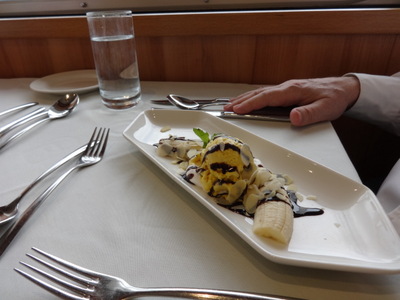
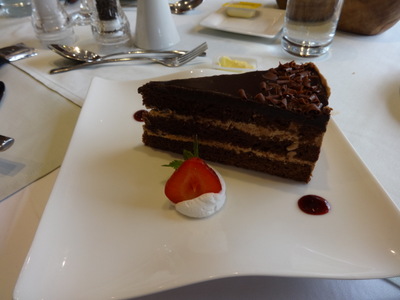 David ordered one of the dessert choices, the banana split, and I ordered the other, the praga (Prague?) cake.
David ordered one of the dessert choices, the banana split, and I ordered the other, the praga (Prague?) cake.
As you can see, the banana split was pretty wimpy by American soda-fountain standards—half a banana, split lengthwise; a scoop of vanilla ice cream; chocolate sauce; sliced almonds; and a mint sprig.
The praga cake, chocoloate cake layered with apricot jam and chocolate ganache, was good, although the apricot jam was barely detectable.
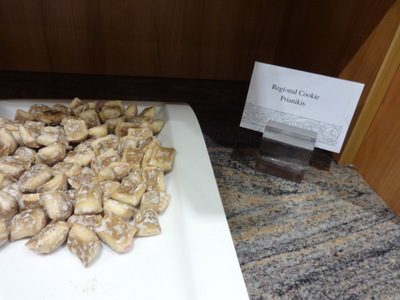
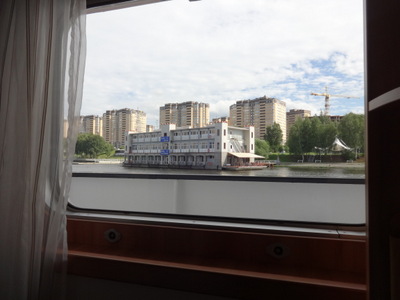 On the way out of the dining room, I paused at the 24-hour coffee-and-cookies station to photograph a new kind of "regional cookie" that appear for the first time that day, "Prianikis."
On the way out of the dining room, I paused at the 24-hour coffee-and-cookies station to photograph a new kind of "regional cookie" that appear for the first time that day, "Prianikis."
By the time we finished lunch, we were out of Moscow and into the countryside. This structure, which appeared to be floating but moored in the river, was labeled "Plav Hotel" (actually "Otel"; Russian probably borrowed the word from French, where the H is silent) and "Restaurant." We saw a word everywhere that looked like "Pectopah" but transliterates as "Restoran" (a pretty good approximation of the French pronunciation of "Restaurant" in a language that, like Russian and English, lacks nasalized vowels).
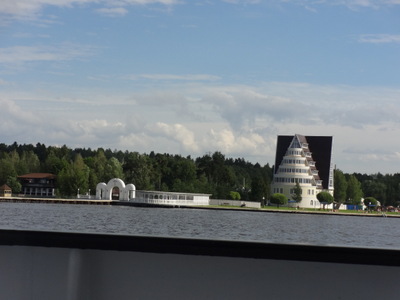
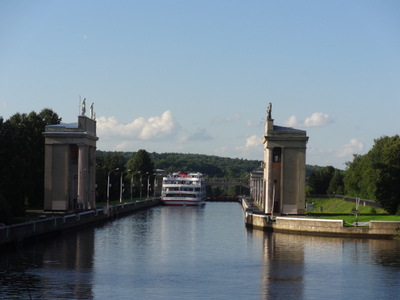 I don't know what these two buildings were. I hypothesize that they're vacation hotels. Two smaller cruise ships are moored in front of the one in the right-hand photo. But they were just about all the buildings there were to see. The banks were mainly thickly clad in woods, mostly of a mixture of white-barked birch and red-barked pine.
I don't know what these two buildings were. I hypothesize that they're vacation hotels. Two smaller cruise ships are moored in front of the one in the right-hand photo. But they were just about all the buildings there were to see. The banks were mainly thickly clad in woods, mostly of a mixture of white-barked birch and red-barked pine.

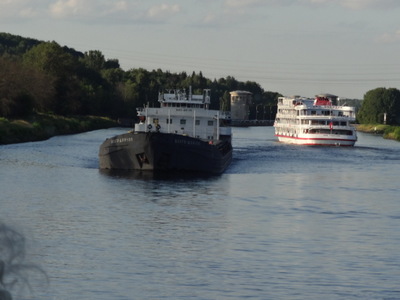 Here's the view off the bow as we approach our first lock. The ship ahead of us, already in the lock, is the Lev Tolstoy, which was moored just in front of us in Moscow. We leapfrogged with it from port to port. We sometimes encountered its passengers in gift shops, and the whole ship seemed to be French speaking. It's not part of the Viking company (as you could deduce because "Tolstoy" is not the name of a Norse god); I think it was with "Croisieurop."
Here's the view off the bow as we approach our first lock. The ship ahead of us, already in the lock, is the Lev Tolstoy, which was moored just in front of us in Moscow. We leapfrogged with it from port to port. We sometimes encountered its passengers in gift shops, and the whole ship seemed to be French speaking. It's not part of the Viking company (as you could deduce because "Tolstoy" is not the name of a Norse god); I think it was with "Croisieurop."
As you can see, the locks are way bigger than the ones on the Douro in Portugal. There, our specially built "baby" longship, the Himming, exactly fit into each lock, with about two feet of clearance front, rear, and on both sides. Here, we (almost twice the size of the Hemming) fit in together with the equally large Tolstoy with room to spare.
The photo at the right shows the view as we cruised out of the lock after dropping down a few meters. That's the red-and-white Tolstoy cruising away ahead of us, and a working ship of some sort (labeled "Volga-Don-195") waiting to take our place in the lock.
This is why we were in such a hurry to leave Moscow and speed down the river. Our captain didn't want to miss his appointment with this lock. If you're not there on time, they go ahead without you and you have to wait your turn, throwing everybody's schedule off.
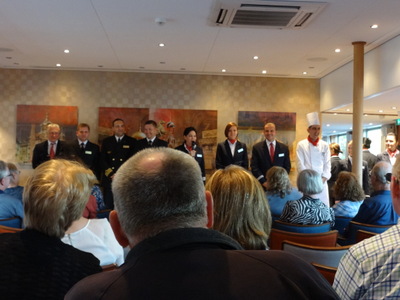
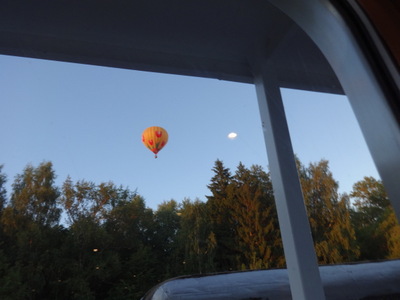 Before our special welcome dinner, we were invited to the Sky Bar (the only space on board large enough to assemble everyone for presentations (the dining room held everyone, but it was wrapped around a central structure housing the service kitchen) to meet the officers. In the center is Karoline, nominally head of hotel services, but pretty clearly generally in charge. She's Austrian and has been with Viking in Russia since its founding in 1997(a self-described "Viking Dinosaur"). The Moscow-St. Petersburg run was Viking's first itinerary, and they hired Karoline from another cruise company where she had been working the same route since 1977!
Before our special welcome dinner, we were invited to the Sky Bar (the only space on board large enough to assemble everyone for presentations (the dining room held everyone, but it was wrapped around a central structure housing the service kitchen) to meet the officers. In the center is Karoline, nominally head of hotel services, but pretty clearly generally in charge. She's Austrian and has been with Viking in Russia since its founding in 1997(a self-described "Viking Dinosaur"). The Moscow-St. Petersburg run was Viking's first itinerary, and they hired Karoline from another cruise company where she had been working the same route since 1977!
To the left of her is the captain, two of his officers, and (I think) the head engineer. To her right are Margo (program director), the maitre d', and the chef. It seemed a little late in the cruise just to be introducing these guys and to serve a welcome dinner, but when I thought about it I realied this was the first time we hadn't been on our way to a tour of something.
After the introductions and a welcome toast, Margo briefed us on our next stop, Uglich (pronounced "oogleech").
The right-hand photo shows a hot-air balloon that drifted by as we ate dinner.
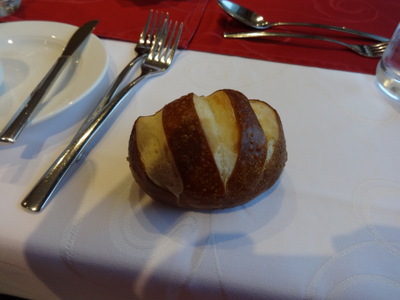
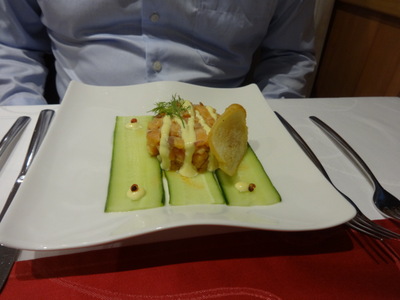 The bread at dinner was pretzel rolls.
The bread at dinner was pretzel rolls.
The right-hand photo shows David's starter, marinated salmon tartar with honey mustard sauce on cucumber carpaccio. I might have ordered that but was tempted away by the pelmeni. David did let me eat the cucumber, though.
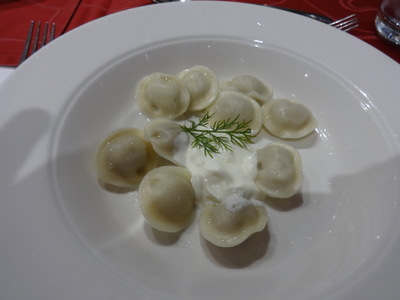
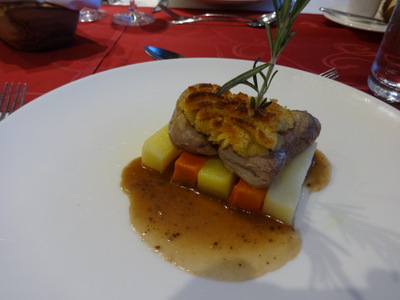 Rachel and I both ordered the Russian specialty, the Siberian pelmini with sour cream, and boy were they a winner! They are little round meat-filled dumplings. Traditionally, you fill circles of dough with dabs of raw ground-meat-and-onion filling, fold them over to form half moons, then pull the corners together and press them together to form circles. You then boil them for 10 minutes and serve with sour cream on top. Yum!
Rachel and I both ordered the Russian specialty, the Siberian pelmini with sour cream, and boy were they a winner! They are little round meat-filled dumplings. Traditionally, you fill circles of dough with dabs of raw ground-meat-and-onion filling, fold them over to form half moons, then pull the corners together and press them together to form circles. You then boil them for 10 minutes and serve with sour cream on top. Yum!
It seems Siberian hunters would make the pelmini to take with them on week-long hunting trips. The raw pelmeni would freeze solid and be piled into sacks. At the evening's campsite, you build a fire, melt some snow in a pot, boil up the pelmeni, and presto a hot meat dinner.
Nobody ordered the mache salad with bacon or the cream of potato soup.
The photo at the right is the veal entrée, veal tenderloin medallions Strindbergh with Pommery sauce. They were coated on top with a strange pasty mixture of breadcrumbs held together with something, and they rested on neatly carved logs of cooked carrot and potato. I think Ev had the beef tenderloin, and nobody ordered the seared cod with leek-potato purée or the potato-vegetable strudel.
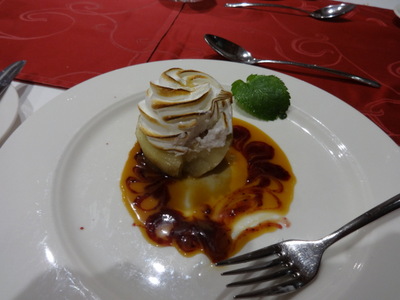 For dessert, nobody ordered the raspberry cake; we all went for the baked apple with meringue on top on a bed of chocolate an caramel sauces, which turned out to be tasty but pretty chewy (the apple, not the meringue).
For dessert, nobody ordered the raspberry cake; we all went for the baked apple with meringue on top on a bed of chocolate an caramel sauces, which turned out to be tasty but pretty chewy (the apple, not the meringue).
Previous entry
List of Entries
Next entry

 Our first stop was Sparrows Hills again, to see it in daylight. It's at 80 m altitude, and we could see about 1/4 of the city from it. The strange multicolored object (with tourist posing in front of it) is advertising the the Festival of Youth, which Will take place in September in Sochi.
Our first stop was Sparrows Hills again, to see it in daylight. It's at 80 m altitude, and we could see about 1/4 of the city from it. The strange multicolored object (with tourist posing in front of it) is advertising the the Festival of Youth, which Will take place in September in Sochi.
 The low, flat dome in the left-hand photo is a huge sports stadium. Behind it and to the left is the building of the Russian Academy of Sciences.
The low, flat dome in the left-hand photo is a huge sports stadium. Behind it and to the left is the building of the Russian Academy of Sciences.
 A feature we hadn't notice in the dark the night before is this large map of Moscow laid out in the pavement (at your feet when you turn your back on the view over the balustrade). You can see the Moscow river winding through the city as well as the two ring roads. The Kremlin is marked by a star in the center of the central reddish circle, and Red Square is visible as the larger area of light-colored "roadway" next to it.
A feature we hadn't notice in the dark the night before is this large map of Moscow laid out in the pavement (at your feet when you turn your back on the view over the balustrade). You can see the Moscow river winding through the city as well as the two ring roads. The Kremlin is marked by a star in the center of the central reddish circle, and Red Square is visible as the larger area of light-colored "roadway" next to it.
 We came to Victory Park (Park Pobedy), via the third ring road, primarily because it's a good place for the buses to let us off so that we can take metro line 2 (the blue one) two stops (to Smolenska) to visit Arbat St., a pedestrian shopping street. The northern terminal of line 2 is the dock where our ship is moored.
We came to Victory Park (Park Pobedy), via the third ring road, primarily because it's a good place for the buses to let us off so that we can take metro line 2 (the blue one) two stops (to Smolenska) to visit Arbat St., a pedestrian shopping street. The northern terminal of line 2 is the dock where our ship is moored.
 As you can see from these photos and the two above the metro stations are beautiful!
A single ticket is 45 rubles (about 75 cents), and it's it will take you anywhere in the city. The guide used a multiride tap card to put us through the turnstiles one at a time. Actually they are automatic flap gates rather than turnstiles; much more comfortable.
As you can see from these photos and the two above the metro stations are beautiful!
A single ticket is 45 rubles (about 75 cents), and it's it will take you anywhere in the city. The guide used a multiride tap card to put us through the turnstiles one at a time. Actually they are automatic flap gates rather than turnstiles; much more comfortable.
 At the far end of our Metro ride, we emerged to this view of the Ministry of Foreign Affairs (one of Stalin's highrises), which is in the process of being cleaned. You can really see the difference between the clean upper floors and the rest, still waiting for attention.
At the far end of our Metro ride, we emerged to this view of the Ministry of Foreign Affairs (one of Stalin's highrises), which is in the process of being cleaned. You can really see the difference between the clean upper floors and the rest, still waiting for attention.
 The shop windows featured all the usual Russian souvenirs, but at a very high level. Whole shops were dedicated to amber carvings and jewelry. At the left here is a window full of painted Easter eggs of all sizes.
The shop windows featured all the usual Russian souvenirs, but at a very high level. Whole shops were dedicated to amber carvings and jewelry. At the left here is a window full of painted Easter eggs of all sizes.
 Our guide was delighted to spot this little blue Soviet-made car parked on the street. It's hard to make out the logo on the front, but I think it's a Lada.
Our guide was delighted to spot this little blue Soviet-made car parked on the street. It's hard to make out the logo on the front, but I think it's a Lada.
 Next, the bus took us to tour St. Saviours cathedral, one of the largest in Russia. To get there, we had to walk over a bridge over the Moscow River. The entrance to the bridge was marked by these flowered arches (it's apparently a popular wedding venue). They're pretty, but again all the flower ar fake.
Next, the bus took us to tour St. Saviours cathedral, one of the largest in Russia. To get there, we had to walk over a bridge over the Moscow River. The entrance to the bridge was marked by these flowered arches (it's apparently a popular wedding venue). They're pretty, but again all the flower ar fake.
 The bridge is embellished with these elaborate wrought-iron lampposts, and while we were there, it was also embellished by our four smiling faces. A fellow Viking cruiser took our photo. You can see the distant towers of the Kremlin just to the left of Ev's head.
The bridge is embellished with these elaborate wrought-iron lampposts, and while we were there, it was also embellished by our four smiling faces. A fellow Viking cruiser took our photo. You can see the distant towers of the Kremlin just to the left of Ev's head.
 The cathedral is an active chuch, so no photos were allowed inside, but here you can see the frieze of figures around the outside. On the original building were they were white marble, but the new ones are made of copper.
The cathedral is an active chuch, so no photos were allowed inside, but here you can see the frieze of figures around the outside. On the original building were they were white marble, but the new ones are made of copper.
 On the way to our final stop of the day, a brief visit to GUM, I finally got a better shot (left-hand photo) of the Hotel Metropol. It's name, in big letters on the side of the building, is hidden by the trees at the right-hand side.
As we walked (from a new direction) toward the entrance to Red Square, we passed a small open-air souvenire market, some temporary flower beds constructed of annuals in planters, and these little plots of grain (wheat, I think). Every now and then Paris does the same thing—sets up flower beds on the steps of the Madeleine and grows wheat down the median of the Champs Elysées.
On the way to our final stop of the day, a brief visit to GUM, I finally got a better shot (left-hand photo) of the Hotel Metropol. It's name, in big letters on the side of the building, is hidden by the trees at the right-hand side.
As we walked (from a new direction) toward the entrance to Red Square, we passed a small open-air souvenire market, some temporary flower beds constructed of annuals in planters, and these little plots of grain (wheat, I think). Every now and then Paris does the same thing—sets up flower beds on the steps of the Madeleine and grows wheat down the median of the Champs Elysées.

 Unfortunately, our time inside GUM was very short, not enough to do any actual shopping or, as I wanted to do, climb up to the food court on the top floor to photograph menus. Rachel did have time to buy an ice cream cone, though. She prides herself on having eaten ice cream in every country she's ever visited.
Unfortunately, our time inside GUM was very short, not enough to do any actual shopping or, as I wanted to do, climb up to the food court on the top floor to photograph menus. Rachel did have time to buy an ice cream cone, though. She prides herself on having eaten ice cream in every country she's ever visited.
 The railings on the second floor, surrounding the central atria, are all decorated with these bicycles, each with a few (presumably artificial) baguettes in its basket.
The railings on the second floor, surrounding the central atria, are all decorated with these bicycles, each with a few (presumably artificial) baguettes in its basket.

 The place really is huge. The vast facade that faces Red Square is only the front of the first range; three more ranges run parallel behind it, all interconnected by crosswise galleries, and each one is three or four stories tall. The hallways and intersections are numbered, to help you keep track of where you are.
The place really is huge. The vast facade that faces Red Square is only the front of the first range; three more ranges run parallel behind it, all interconnected by crosswise galleries, and each one is three or four stories tall. The hallways and intersections are numbered, to help you keep track of where you are.

 We briefly lost track of one member of our group (her husband bypassed their agreed rendezvous point and rejoined the group without her while she waited for him), but the assistant guide had stayed with her and sorted it out by phone with the head guide. As a result, we were running a little late and had a deadline to meet, so it was back into the buses and off to the ship. On the way, I finally got a good shot of the renovations taking place. In the left-hand photo, you can see buys sitting or standing on planks suspended from the roof of a building, painting its facade. Above them, the paint is bright an attractive. Below them, it's all gray, discolored and scarred (probably worse that it looked before they arrived, because they surely scraped the whole thing down before beginning the repainting job.
We briefly lost track of one member of our group (her husband bypassed their agreed rendezvous point and rejoined the group without her while she waited for him), but the assistant guide had stayed with her and sorted it out by phone with the head guide. As a result, we were running a little late and had a deadline to meet, so it was back into the buses and off to the ship. On the way, I finally got a good shot of the renovations taking place. In the left-hand photo, you can see buys sitting or standing on planks suspended from the roof of a building, painting its facade. Above them, the paint is bright an attractive. Below them, it's all gray, discolored and scarred (probably worse that it looked before they arrived, because they surely scraped the whole thing down before beginning the repainting job.
 David ordered one of the dessert choices, the banana split, and I ordered the other, the praga (Prague?) cake.
David ordered one of the dessert choices, the banana split, and I ordered the other, the praga (Prague?) cake.

 On the way out of the dining room, I paused at the 24-hour coffee-and-cookies station to photograph a new kind of "regional cookie" that appear for the first time that day, "Prianikis."
On the way out of the dining room, I paused at the 24-hour coffee-and-cookies station to photograph a new kind of "regional cookie" that appear for the first time that day, "Prianikis."
 I don't know what these two buildings were. I hypothesize that they're vacation hotels. Two smaller cruise ships are moored in front of the one in the right-hand photo. But they were just about all the buildings there were to see. The banks were mainly thickly clad in woods, mostly of a mixture of white-barked birch and red-barked pine.
I don't know what these two buildings were. I hypothesize that they're vacation hotels. Two smaller cruise ships are moored in front of the one in the right-hand photo. But they were just about all the buildings there were to see. The banks were mainly thickly clad in woods, mostly of a mixture of white-barked birch and red-barked pine. Here's the view off the bow as we approach our first lock. The ship ahead of us, already in the lock, is the Lev Tolstoy, which was moored just in front of us in Moscow. We leapfrogged with it from port to port. We sometimes encountered its passengers in gift shops, and the whole ship seemed to be French speaking. It's not part of the Viking company (as you could deduce because "Tolstoy" is not the name of a Norse god); I think it was with "Croisieurop."
Here's the view off the bow as we approach our first lock. The ship ahead of us, already in the lock, is the Lev Tolstoy, which was moored just in front of us in Moscow. We leapfrogged with it from port to port. We sometimes encountered its passengers in gift shops, and the whole ship seemed to be French speaking. It's not part of the Viking company (as you could deduce because "Tolstoy" is not the name of a Norse god); I think it was with "Croisieurop."
 Before our special welcome dinner, we were invited to the Sky Bar (the only space on board large enough to assemble everyone for presentations (the dining room held everyone, but it was wrapped around a central structure housing the service kitchen) to meet the officers. In the center is Karoline, nominally head of hotel services, but pretty clearly generally in charge. She's Austrian and has been with Viking in Russia since its founding in 1997(a self-described "Viking Dinosaur"). The Moscow-St. Petersburg run was Viking's first itinerary, and they hired Karoline from another cruise company where she had been working the same route since 1977!
Before our special welcome dinner, we were invited to the Sky Bar (the only space on board large enough to assemble everyone for presentations (the dining room held everyone, but it was wrapped around a central structure housing the service kitchen) to meet the officers. In the center is Karoline, nominally head of hotel services, but pretty clearly generally in charge. She's Austrian and has been with Viking in Russia since its founding in 1997(a self-described "Viking Dinosaur"). The Moscow-St. Petersburg run was Viking's first itinerary, and they hired Karoline from another cruise company where she had been working the same route since 1977!
 The bread at dinner was pretzel rolls.
The bread at dinner was pretzel rolls.
 Rachel and I both ordered the Russian specialty, the Siberian pelmini with sour cream, and boy were they a winner! They are little round meat-filled dumplings. Traditionally, you fill circles of dough with dabs of raw ground-meat-and-onion filling, fold them over to form half moons, then pull the corners together and press them together to form circles. You then boil them for 10 minutes and serve with sour cream on top. Yum!
Rachel and I both ordered the Russian specialty, the Siberian pelmini with sour cream, and boy were they a winner! They are little round meat-filled dumplings. Traditionally, you fill circles of dough with dabs of raw ground-meat-and-onion filling, fold them over to form half moons, then pull the corners together and press them together to form circles. You then boil them for 10 minutes and serve with sour cream on top. Yum! For dessert, nobody ordered the raspberry cake; we all went for the baked apple with meringue on top on a bed of chocolate an caramel sauces, which turned out to be tasty but pretty chewy (the apple, not the meringue).
For dessert, nobody ordered the raspberry cake; we all went for the baked apple with meringue on top on a bed of chocolate an caramel sauces, which turned out to be tasty but pretty chewy (the apple, not the meringue).